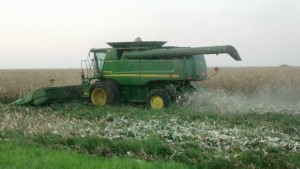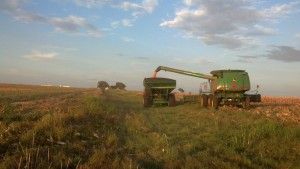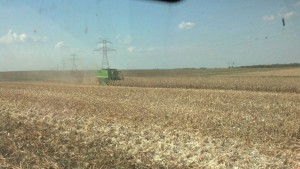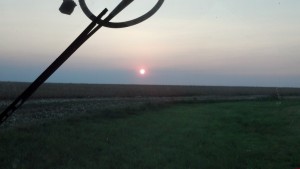Saturday, August 24, 2013, Uncle Joe and Brother Charles completed this year’s corn harvest.
Here you see the combine beginning to go after the last few acres.
This year, Uncle Joe had about 1,300 acres in corn. Corn is the biggest crop. It was a close one to even make a crop. Normally, the last freeze in Central Texas is around March 15th, the Ides of March. This year the thermometer dipped to 22 degrees Fahrenheit (5.6 Celsius) on the morning of April 26th. That is an extremely cold start for young corn. Uncle Joe was amazed. He said you can lose the entire crop when it freezes that hard so late in the season. There were some damaged stands, but the corn largely just kept growing. It was a miracle.
Here you see the kernels moving from the combine’s bin to the grain buggy.
Joe says this year’s yields are pretty decent, averaging about 100 bushels of corn to the acre. The corn harvest was delayed by late summer rains. Uncle Joe and Charles started July 24th and finished yesterday evening. That’s a month to get the corn harvested and delivered to the grain elevators for market. Uncle Joe said the grain elevator operators kept closing earlier and earlier, and he had some of the last corn to be harvested this year.
Here you see the combine on the last few rows.
After the corn, there won’t be much of a break. The cotton fields are ready to be defoliated. Once the leaves fall off, the white cotton bolls can be stripped from the stalks and pressed into truck-sized modules for transport to the cotton gin. At the gin, the seed is separated and the raw fiber baled and sent on to market. Aunt Martha manages the local cotton gin and has for over fifty years.
Cotton is the last of the four crops harvested each year: The first crop is the winter wheat, then the milo, next the corn and finally the cotton. Cotton and wheat are the slowest to harvest, with the cotton stripper processing about 40-50 acres a day and wheat reel moving at a 60-acre pace on a good day. For corn and milo, the combine with the big headers can handle about 70-75 acres per day. Both the wheat and milo harvests have been pretty good. Uncle Joe was the first to the elevators with milo. The wheat averaged 58 bushels an acre, and milo returned at 4,000 pounds for a typical acre.
The wheat harvest started about a month late this year on June 1st and lasted about a week. The transition to milo began on June 12th and lasted until July 22nd. As noted above, corn started on July 24th and just finished on August 23rd. Now, the cotton begins.
As you can see, there is not much time to rest for the farmer at his work, which is why Uncle Joe and Charles were happy to watch the last rows of corn fall at sunset last night.
When the cotton is done, the fields need to be prepared for the next round of crops; and then it starts over again.
At harvest’s end, another day’s begun.
My hat’s off to the farmer,
Grandpa Jim




